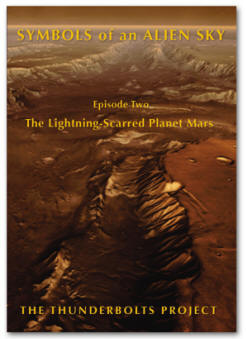|

Lightning strikes the Burj Khalifa
tower in Dubai. Credit: Alisdair
Miller
Dielectric Breakdown
Jun
16, 2011
Glass, plastics, and various
metal oxides are efficient
dielectric insulators. Dry air is
another example.
A capacitor is used to accumulate
and store electric charge.
Capacitors are usually made of two
conductors separated by an
insulating medium, or dielectric
insulator. An electric charge on one
conductor attracts an opposite
charge to the other conductor,
resulting in an electric field
between them that acts as an
electrical energy reserve.
As charges inside the capacitor
increase, the electric field
increases, stressing the insulator's
ability to keep them separate. If a
high enough potential grows between
the two conductive plates, the
dielectric insulator will fail and
the capacitor will short circuit,
suddenly releasing the stored
energy.
It is that phenomenon that most
likely contributes to lightning
discharges. Stored electrical energy
in the clouds and in the ground
overcome the atmosphere's ability to
keep the two charges separate, so
they reach out to each other in the
form of "leader strokes." When the
two lightning leaders meet, a
circuit between the clouds and the
ground (or between one cloud and
another) is completed and a burst of
electric current flashes along the
conductive pathway.
Lightning's "arc mode" effect is
only one way that the electricity
can behave. There are also so-called
"glow discharges," often observed
high above the clouds as "red
sprites" and "blue jets." There
might also be what are known as
"dark" discharges. These could be
powerful electric currents but they
are unseen and difficult to detect.
An "ionic wind" can reveal the
presence of a dark discharge, such
as that from an electric air
purifier.
In thunderstorms, dark mode
discharges drag surrounding neutral
air molecules along with the charged
particles. The strong winds into and
out of such storms appear as
updrafts and downdrafts. A mark of
their power can be seen in any
rapidly rotating system, like a
tornado. They can lift dirt and
rocks, erode surfaces, and
accelerate materials to extreme
velocity. In an Electric Universe,
those storms are therefore not
produced solely through hot air
convection. Instead, thunderstorms
could be a secondary phenomenon
driven by an invisible dielectric
breakdown of Earth's atmospheric
insulator.
Electrostatic forces would be
responsible for suspended dust or
water in storms. This explains why
hailstones are most often spherical.
An electric field carries charged
water molecules more easily than
would powerful winds trying to hold
several grams of ice up against the
pull of gravity. If winds are
pushing hailstones back up into the
cloud to add layers of ice each
time, they ought to show distorted
and random shapes from the chaotic
nature of wind.
Human beings are not well-equipped
to sense electric and magnetic
fields. However, the feel of a
breeze or the chill of a wind are
readily detected. This can lead to
an idea that all weather is
convective in nature, depending only
on the rise of hot air and the fall
of its cold analog. In consensus
viewpoints, lightning appears to be
an aftereffect of that convection,
so the electrical interactions
between Earth and its surrounding
charged plasma sheath are
overlooked.
Electrical phenomena are scalable:
they demonstrate characteristics
that are alike whether the spark
spans a millimeter or thousands of
kilometers. Tiny electric arc scars
are seen with a microscope on
insulators and semiconductors. As
previous Picture of the Day articles
have shown, those arc scars can be
seen on the faces of planets and
moons, as well. How powerful might
be an interplanetary lightning bolt?
Plasma physicist Anthony Peratt
estimated that a single such bolt
could be as powerful as a 3,000,000
megaton nuclear explosion.
Stephen Smith
 New
DVD New
DVD
The Lightning-Scarred
Planet Mars
A video documentary that could
change everything you thought you
knew about ancient times and
symbols. In this second episode of
Symbols of an Alien Sky, David
Talbott takes the viewer on an
odyssey across the surface of Mars.
Exploring feature after feature of
the planet, he finds that only
electric arcs could produce the
observed patterns. The high
resolution images reveal massive
channels and gouges, great mounds,
and crater chains, none finding an
explanation in traditional geology,
but all matching the scars from
electric discharge experiments in
the laboratory. (Approximately 85
minutes)
Video Selections
Order Link
|





 New
DVD
New
DVD

